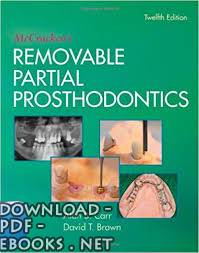📘 قراءة كتاب McCracken's Removable Partial Prosthodontics أونلاين


التعويضات السنية Prosthodontics وتشمل
الجسور الثابتة Fixed bridges والزرعات Implants
الطقوم الكاملة المتحركة removable complete denture
الطقوم الجزئية المتحركة removable partial denture
معالجة و إصلاح الأسنان Operative Dentistry وتشمل:
تشخيص تسوس الأسنان caries diagnosis
الوقايه والحد من انتشار تسوس الاسنان management of dental caries
تبييض الأسنان Dentalbleaching
تجميل الأسنان cosmetic dentistry
حشوات الأسنان Dental Fillings
معالجة لب الأسنان Endodontics
معالجة الأسنان المجهرية microscopic endodontics
طب الأسنان الوقائي Preventive Dentistry
تقويم الأسنان Orthodontics
جراحة الفم والوجه والفكين Oral and Maxillofacial Surgery
طب أسنان الأطفال Pedodontics
أمراض اللثة
أمراض الأنسجة المحيطة بالأسنان Periodontics
زراعة الأسنان Dental Implantology
أشعة الأسنان Dental Radiology
طب الأسنان الشرعي Forensic Dentistry
طب الفم Oral Medicine
أمراض الفم Oral Pathology
أنسجة الفم والأسنان Oral Histology
المادة السنية Dental material
تشريح الأسنانDental anatomy
مواضيع متعلقة بطب الأسنان
طب الأسنان للرضع
جراحة الأسنان
أسنان
طقم أسنان
طب الاسنان في الاردن
طب الأسنان في جميع أنحاء العالم
McCracken's Removable Partial Prosthodontics, 12e 12th Edition
by Alan B. Carr DMD MS (Author), David T. Brown DDS MS )
Preface
With this new edition, we once again recognize the opportunity
to provide useful and updated instruction in the field
of removable partial prosthodontics as a significant responsibility.
Removable partial dentures (RPDs) continue to
be an option for tooth replacements worldwide. As dental
implant use continues to grow in both application and scope
as an option for stabilizing replacement teeth, RPDs remain
the prosthesis of choice for many patients and clinical situations,
making the need for a continued sound educational
foundation necessary.
Though dentists will always be challenged as to whether
they should try new techniques, devices, and materials in
practice, appropriate care of the partially edentulous patient
continues to require careful attention to basic prosthodontic
principles. At issue with RPD care is always how well a new
approach augments provision of the required support, stability,
and retention—foundational principles for all tooth
replacement prostheses.
In the Preface of the last edition, functional stability was
highlighted as a critical consideration. As a therapeutic goal
this remains to be the case as the evidence that brought the
functional stability concern to light has not been countered.
What has emerged as a means to efficiently address the issue
of instability under function with RPDs is an increased
application of implants for stabilizing RPDs in patients who
are able to take advantage of them. The authors consider
selective use of dental implants to address meaningful concerns
identified in an individual patient related to support
and stability to be laudable goals of treatment using RPDs.
This edition of McCracken’s Removable Partial Prosthodontics
has attempted to embed implant considerations
into the diagnostic and treatment considerations basic to
RPD care. Implant use in RPDs is also addressed in Chapter
25, which reinforces implant application specific to limitations
found in clinical examination. Where support is found
to be a major limitation, or when functional instability is
likely to be related to chronic mucosal pain, these are applications
in which treatment goals are positively impacted
through selective location of dental implants. When accomplished
with a consideration of future patient needs based
on an individual risk assessment, maintenance of a functional
occlusion over time becomes a proactive, patient care
planning, and education process, not a reactive response. It
is obvious that continued application of implants with RPDs
will necessarily lead to attempts at modification of prosthesis
designs. The rationale of such modifications must balance
the material requirements for durability, patient perception
advantages to reduced bulk, and the biological tolerance of
all oral tissues involved.
This edition continues to use modifications incorporated
in recent past editions that were responses to evolving
student learning needs. To provide a perspective for understanding
the impact of removable partial denture prosthodontics,
a review of tooth loss and its sequelae, functional
restoration with prostheses, and prosthesis outcomes is provided
at the outset to define a context for the student. Additionally,
new art and color clinical photographs have been
provided to completely update material that supplements
the text. We continued the strategy begun with the last
edition of making a content distinction to facilitate both the
first-time learner and the more experienced clinician. The
convention used was to separate the advanced level material
by shaded boxes. This was accomplished with the full understanding
that such a distinction is not always clear, and that
some readers will object to how certain material was classified.
Our hope is that it will help clarify the material for the
majority of readers.
Alan B. Carr
David T. Brown
Table of Contents
PART I: GENERAL CONCEPTS/TREATMENT PLANNING
1. PARTIALLY EDENTULOUS EPIDEMIOLOGY, PHYSIOLOGY, AND TERMINOLOGY
2. CONSIDERATION FOR MANAGING PARTIAL TOOTH LOSS
3. CLASSIFICATION OF PARTIALLY EDENTULOUS ARCHES
4. BIOMECHANICS OF REMOVABLE PARTIAL DENTURES
5. MAJOR AND MINOR CONNECTORS
6. RESTS AND REST SEATS
7. DIRECT RETAINERS
8. INDIRECT RETAINERS
9. DENTURE BASE CONSIDERATIONS
10. PRINCIPLES OF REMOVABLE PARTIAL DENTURE DESIGN
11. SURVEYING
PART II: CLINICAL AND LABORATORY
12. DIAGNOSIS AND TREATMENT PLANNING
13. PREPARATION OF MOUTH FOR REMOVABLE PARTIAL DENTURES
14. PREPARATION OF ABUTMENT TEETH
15. IMPRESSION MATERIALS AND PROCEDURES FOR REMOVABLE PARTIAL DENTURES
16. SUPPORT FOR THE DISTAL EXTENSION DENTURE BASE
17. OCCLUSAL RELATIONSHIPS FOR REMOVABLE PARTIAL DENTURES
18. LABORATORY PROCEDURES
19. WORK AUTHORIZATIONS FOR REMOVABLE PARTIAL DENTURES
20. INITIAL PLACEMENT, ADJUSTMENT, AND SERVICING OF THE REMOVABLE PARTIAL DENTURE
PART III: MAINTENANCE
21. RELINING AND REBASING THE REMOVABLE PARTIAL DENTURE
22. REPAIRS AND ADDITIONS TO REMOVABLE PARTIAL DENTURES
23. INTERIM REMOVABLE PARTIAL DENTURES
24. REMOVABLE PARTIAL DENTURE CONSIDERATIONS IN MAXILLOFACIAL PROSTHETICS
25. CONSIDERATIONS FOR THE USE OF DENTAL IMPLANTS WITH REMOVABLE PARTIAL DENTURES
APPENDIX A: GLOSSARY
APPENDIX B: SELECTED READING RESOURCES
كتب طب اسنان
كتب طبية باللغة العربية pdf
كتب طب اسنان مترجمة
كتب تقويم اسنان بالعربي
كتب طب الاسنان في مصر
كتب طب اسنان بالعربي pdf
البسيط في تقويم الأسنان pdf
كتب طب اسنان سنة اولى
تحميل كتب في تقويم الاسنان
حجم الكتاب عند التحميل : 31.3 ميجا بايت .
نوع الكتاب : pdf.
عداد القراءة:
اذا اعجبك الكتاب فضلاً اضغط على أعجبني و يمكنك تحميله من هنا:

شكرًا لمساهمتكم
شكراً لمساهمتكم معنا في الإرتقاء بمستوى المكتبة ، يمكنكم االتبليغ عن اخطاء او سوء اختيار للكتب وتصنيفها ومحتواها ، أو كتاب يُمنع نشره ، او محمي بحقوق طبع ونشر ، فضلاً قم بالتبليغ عن الكتاب المُخالف:
 قبل تحميل الكتاب ..
قبل تحميل الكتاب ..
يجب ان يتوفر لديكم برنامج تشغيل وقراءة ملفات pdf
يمكن تحميلة من هنا 'http://get.adobe.com/reader/'


 منصّة المكتبة
منصّة المكتبة